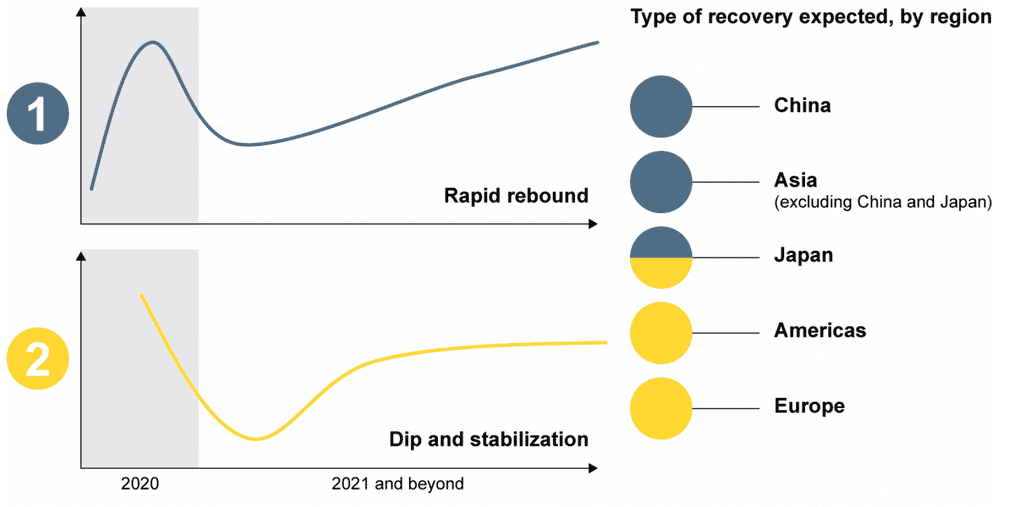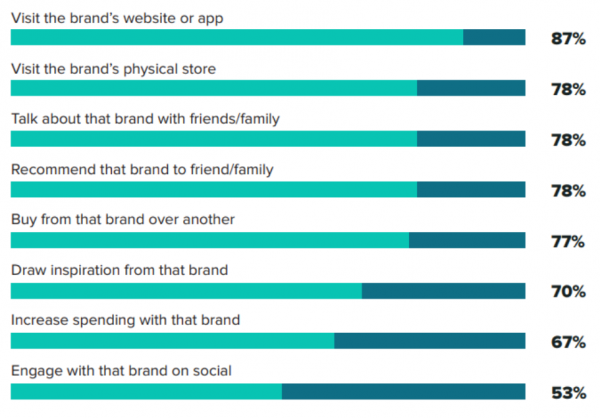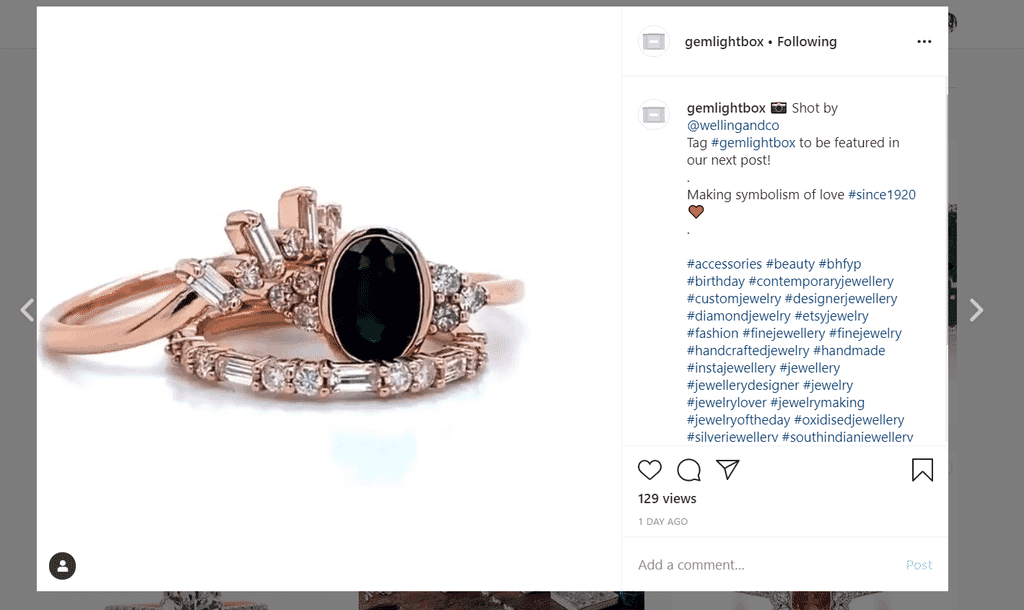Jewelry ECOMM Tech
How to Sell Jewelry in the New Normal November 18, 2020 (0 comments)

According to Bain & Company, the devastating impact of COVID-19 will continue to reverberate into 2021 although, the recovery may vary for different countries. For instance, Asian markets including China but excluding Japan are highly likely to rebound faster while the Americas, Europe, and Japan might feel the impact far longer before experiencing marketing stabilization again, see data below.

As dire as the situation appears to be, there are many things you can do to prevent the complete decline of your business. These are adaptive approaches you have probably ignored in the past, but as you would see, are inevitable now.
Indeed, the ‘new normal’ is here and it’s about to test your adaptability, so let’s begin!
How to Sell Jewelry in the New Normal
1. Virtual selling is the new normal.

With movement restriction and social distancing measures in place, virtual space has been a major retail hub for many. Navigating the digital space is nothing new for jewelers who initially entered the market digitally; however, for those who were thriving in a face-to-face retail environment, you’re in uncharted waters here.
There are different digital channels to explore when moving from bricks to clicks in these difficult times. Each channel has its own drawbacks and benefits as you will find out below.
Social Media
While social media networks, such as Facebook, Instagram, and Pinterest among many others, are hardly the last point of purchase, they are among your strongest weapons when branching out on virtual selling. In fact, 90% of social media users reached out to brands on the platform to learn more about them and/or their products; hence, it is not more about closing the deal but more about creating and enhancing a compelling customer journey, see data below.

Source: 2019 Sprout Social Index by Sprout Social
Creating a social media page for your brand does not end there. You would need consistency to keep your followers engaged to avoid follower growth and content stagnation.
There are many strategies you can adopt to map out the customer journey effectively. The strategies may include but not limited to the following:
- Develop an omnichannel presence.
Adopt a multichannel approach instead of focusing on just one social media platform. The key here is to be wherever your target customers are so you’re not leaving money on the table. Each platform has its own strengths and weaknesses, but adopting a multiple channels approach transitions your customers seamlessly between your different channels; thereby, improving their engagement, satisfaction, and overall experience.
- Craft engaging content.
There are two ways you can craft an engaging content. First, using your own organic posts and second, by leveraging user-generated content, as shown respectively in the examples below.

Source: GemLightbox

Based on statistics, a combination of videos and images would benefit your brand. This is because 54% of customers wanted to see more videos from the brands they support while posts with images received 6.5x more engagement. Overall, visual content is 40% highly likely to be shared on social media and this is good if you’re aiming for virality.
When posting visual content, make sure that your product videos and images are studio-quality and tell an authentic and genuine story; otherwise, it will put off target viewers. Remember, you only have 50 milliseconds to impress an easily-distracted audience.
- Find out what your audience thinks.
You cannot solve a problem if you cannot identify it. Similarly, you cannot meet people’s needs if you don’t know what they are. Do not hesitate to used question-based posts. They are your key to valuable market insights that will ultimately inform your content, product development, and marketing strategies. It is also an excellent way to stimulate interaction and keep your audience engaged.
E-Commerce Platforms
Still in the virtual selling category, e-commerce platforms are popular among retailers who are considering selling jewelry in the new normal. Jewelers who are just starting their journey in the digital world might often prefer e-commerce platforms than setting up their own because it is easy and convenient. E-commerce platforms eliminate friction points and make the process convenient for both the buyers and sellers.
There are many e-commerce platforms these days. These include the following:
- Amazon
While Amazon also focuses on cloud artificial intelligence, cloud computing, and digital streaming, it is most popularly known as the e-commerce dream where through its multi-leveled e-commerce strategy, allows sellers to sell almost anything to buyers from its platform.
Amazon has a total of 8.6 million sellers globally with 2.1 million active sellers, over 200 million unique visitors per month, and sells over 12 million products.
You can also sell fine jewelry and handmade jewelry on Amazon, although the processes vary for premium products. Stricter seller requirements are in place to ensure the authenticity of the products being sold. This is for the protection of both the sellers and buyers.
- eBay
eBay is another large e-commerce corporation that facilitates sales from business to consumer and from customer to consumer through its platform. eBay is known for its auction-style sales but has also expanded by adding a ‘Buy it Now’ option.
As of the first quarter of 2020, eBay has 174 million active buyers and over 1 billion active listings.
Selling jewelry on eBay is easier than imagined as it only requires you to set up a business account. eBay offers many advantages to the sellers. It is flexible with pre-built infrastructure while also giving you more control over your listings.
- Etsy
Etsy is an e-commerce website focusing on handmade and vintage items and craft supplies among many others. These items can cover a wide range of categories from Jewelry & Accessories, Home & Living, Wedding & Party, Craft Supplies & Tools, to Clothing & Shoes just to name a few.
As of 2019, Etsy has recorded over 2.5 million sellers and over 39.4 million active Etsy buyers globally. However, Etsy is an oversaturated market for jewelers. For instance, a quick look at the Jewelry & Accessories category will already give you over 18 million product listing search results. Nonetheless, selling jewelry on Etsy is the most affordable but you have to beat the competition.
Your own website
Selling on e-commerce platforms might be easier than setting up your own website, but the former has many limitations. For instance, you’re subject to the platform’s policies and guidelines, which if you’re not careful, can boot you out of their marketplace. Their fees may also change, and you can only do so much when it comes to personalization.
Given the above, if you’re looking towards building a more personalized online presence and establishing a meaningful long-term relationship with your buyers, then having your own website is the most professional solution for you.
When setting up, remember that visual presentation and user experience are the two key elements that make a good jewelry website; hence, when designing, design with your target customers in mind. Make your website easy to navigate and the checkout process, simple in order to enhance their shopping experience.
2. Organize virtual events.

Virtual events are online exhibitions that can be enabled on different platforms like smartphones, laptops, desktops, or tablets. Virtual events are not restricted to webinars and web or video conferencing. You can also use it to organize sales events, customer acquisition, new product announcements, and more.
Virtual events are the new normal. The rise of virtual events can attest to this new trend. In fact, 7 of 10 polled respondents have moved their in-person events to virtual platforms. This is not to say that virtual events will completely replace in-person events but rather the beginning of a hybrid solution in which organizations will manage both virtual and in-person events.
You can plan many jewelry virtual shopping events. Among these are virtual trunk shows, private viewing, trade shows, or simply host a live video event to showcase all your products while engaging with your audience at the same time.
3. Create digital catalogs.

Catalogs are a complete list of products that people can buy from you. Catalogs are not a novel idea but it does work in reaching out directly to clients, especially in difficult times when clients cannot do in-store shopping.
You can either opt for traditional print catalogs or digital ones, but make sure that either way, you must always couple your product descriptions with professional-quality images; otherwise, it will not work given the visual component of the approach.
If you’re iffy about the plausibility of traditional catalogs, suppress that thought. According to a study published in the Harvard Business Review, catalogs are making a comeback reasonably based on large field experiments. In their study involving a luxury and jewelry e-commerce retailer, they mentioned that compared to email marketing only, the retailer who sent both email marketing AND catalogs experienced a 49% increase in sales and a 125% increase in inquiries. Compare this to 28% and 77% respective increases derived from email only, you can say that the catalogs are effective sales driver.
Reasons why catalog works:
There are many psychologically-driven reasons as to why catalogs still work, according to the study.
- Catalogs are a marketing powerhouse for its visual appeal. The images in it enhance the clients’ ability to visualize the products and really imagine how the products would look on them when worn. This visual appeal heightens the vividness of the products, which then elevates the clients’ shopping experience that ultimately influences their buying behavior.
- Catalogs are a good alternative for jewelers who don’t have sufficient financial resources to put up a physical store. It’s cheaper without compromising on the shopping experience. With a well-designed catalog and professional-quality jewelry images, you can still provide your clients with a shopping experience that is fun, tactile, and vivid.
- Catalogs make your product presentation memorable. Unlike email marketing materials that clients can delete in just a click, print catalogs stay with them; thereby, increasing top-of-mind awareness.
As a final tip, do not forget to personalize your catalogs before sending them to clients. Write them a personal message and address them by name to create a positive impression and fantastic response.
4. Cultivate community connection.

The limitations brought about by the pandemic have shaped a newly-found localism and sense of community. Such trend occurs at a time when movement restrictions made people rely on independent retailers and local stores.
If you’re an independent jewelry retailer, this is an opportunity for you to build those connections as locals would highly likely support local, independent stores in these difficult times.
Kantar, a data, insights, and consulting company, observes that buying local is one of the three significant behavioral changes that will likely stick in a post-pandemic. Leverage that opportunity and make sure that the community where you operate knows you exist and that they can reach out to you, especially during gift-giving seasons.
5. Practice empathy and support causes.

Show solidarity with people in need by supporting causes that aim to help those in need. For instance, the high jewelry house Graff had shown solidarity with the rest of the world by donating US$1 million to the World Health Organization’s COVID-19 Solidarity Response Fund. The donation will help provide critical aid to the most vulnerable and at-risk countries.
Of course, showing solidarity does not only mean extending financial support. If you’re a small business owner, you can put this into action by focusing on customer experience — making sure that your business delivery and customer interaction are empathetic and meaningful.
With many people globally experiencing difficult times, always communicate with empathy. Other retailers have already put this into action by offering contactless, curbside pickup, expanded delivery options, and more.
Technology and innovation will play a major role in putting empathy into practice as customer care should be the priority. For instance, instead of bombarding them with marketing emails, you can reach out to them with a voice of support and concern. You can also innovate your digital platforms to make it more convenient for them, and always have an available customer service to attend to their queries.
Customer service availability is essential because buying jewelry online might be a new thing for others. Don’t let them fall by the wayside. Ensure that you have all the resources they need to make them informed and well-guided.
Are you ready for the new normal?
Today’s situation doesn’t really give jewelers any option but to adapt. You have to survive the ‘now’ so you can be there for the customers of tomorrow.
Tough times call for bold decisions.
Treat this as an opportunity to re-calibrate your business processes to become agile and innovative. The truth is, COVID-19 has changed and will continuously change consumer behavior and buying habits, and the only way forward is to become bold, especially digitally.
Do you already have plans on how to sell jewelry to customers in the new normal? Let us know in the comment section below!


